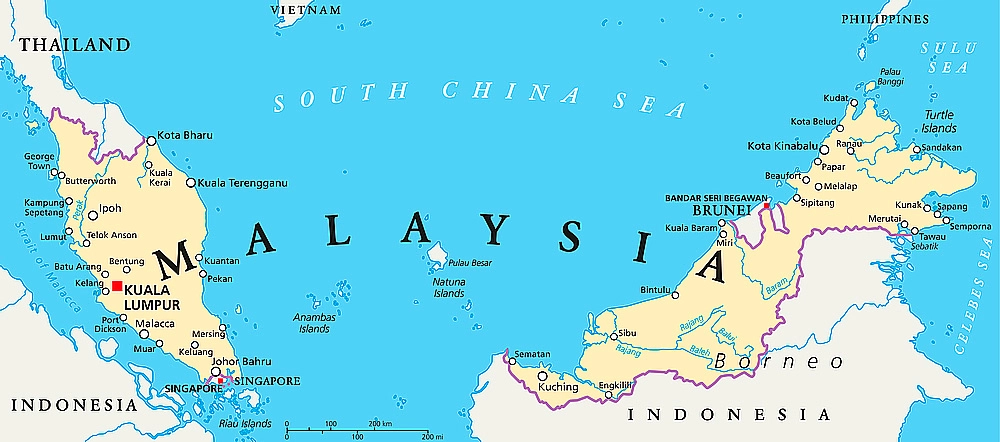2024/6/26 Malaysia to apply to join BRICS
Malaysia has decided to apply for BRICS membership and will start filing the official paperwork soon, Malaysian Prime Minister Anwar Ibrahim has said. Existing BRICS member South Africa has agreed to accept a request. Anwar said “We have made our policy clear and we have made our decision. We will start the formal process to join BRICS soon. We are waiting for the final result and the feedback from the South African government.”
Kuala Lumpur’s potential membership in the organization would be of strategic significance, as one of the world’s most important shipping lanes — the Malacca Strait, connecting the Pacific and the Indian Ocean — is located between Malaysia and the Indonesian island of Sumatra.
According to Anwar, Malaysia is “relieved” that the world is no longer unipolar, and that the rise of BRICS and China in particular has offered “a glimmer of hope that there are checks and balances in the world.”
The West wants to “control the discourse” in the world, but “we can no longer accept it because they are no longer a colonial power and independent countries should be free to express themselves,” Anwar said.
Earlier this month, Russian Ambassador to China Igor Morgulov said that about 30 countries have voiced a desire to join BRICS. In South Asia, Thailand, Sri Lanka and Vietnam have already made requests to join. Russian President Putin has visited Vietnam in June 19.
Malaysia has a population of 34 million and a GDP (PPP) of US$1.3 trillion. It is a liberal Muslim country, and has a significant tourist industry. Its main exports are petroleum along with other natural and agricultural resources, including rubber and palm oil. It has significant manufacturing and service industries.
Russia Malaysia 2024 Trade & Development
Total Russia-Malaysia trade reached about US$3.2 billion in 2023, with about US$2.1 billion of this being Russian exports. Malaysia remains a key importer of Russian agricultural products, bringing in grains, oilseeds, meat, and dairy products. In return, Russia receives palm oil, rice, and fruits from Malaysia. Energy resources, primarily oil and gas, along with metals and chemical products, form the crux of exports from Russia to Malaysia.
Malaysia reciprocates with exports of cars, electronics, rubber, and palm oil. Russia is also interested in exporting Malaysian high-tech equipment.
Malaysia is also one of Asia’s largest semiconductor exporters with an annual volume of US$8.7 billion. The electronics sector contributes almost 6% of Malaysia’s GDP. Russia is also interested in medical products, and medical equipment, in particular in the field of dentistry. Around 31-32% of Malaysian exports to Russia are electronic goods. Malaysia has a developed auto industry, in particular the Proton and Perodua brands. In 2022, the country produced more than 700,000 cars — more than Russia.
Given the flight of Western companies from the Russian market the latter is now more open to the influx of Malaysian cars. This fits into the overall shift that is taking place in Russia since early 2022 — Asian car brands are becoming increasingly attractive to Russian customers.
Russian and Malaysian companies have now increasingly been switching to payments in Chinese RMB Yuan, UAE Dirhams, and other currencies. Yet for this mechanism to work, there must be common elements between participating states. Among the most important elements is the issue of determining the volume of trade and investment, which should be significant for payments in non-dollar currencies to be effective.
Another strategic move by the two countries to boost trade and investment is the finalization of a new Double Tax Agreement (DTA) between the two nations. This treaty aims to streamline and simplify the tax regime for businesses operating in both countries, fostering a more conducive environment for mutual investments. This treaty will set a standard 15% withholding tax rate on dividends. A 10% concessional rate will apply to recipients who hold a minimum of 25% of the capital in the dividend-distributing company. This follows an agreement signed in 2019 which covers mutual cooperation and the development of relations between Russia and Malaysia.
In a noteworthy event in May 2023, the “Russia — Islamic World: Kazan Forum” provided an avenue for detailed discussions on trade. Within this forum, the “Russia-Malaysia” segment facilitated by the Trade Mission of the Russian Federation in Malaysia and the Ministry of Economic Development of the Russian Federation explored ways to further amplify the trading relationship.
Both countries recognize the need for deeper bilateral and EAEU-ASEAN cooperation. In this regard, there are still notable challenges to address, particularly relating to standards and adherence. ASEAN remains predominantly driven by trade motivations, not geopolitics. While there are administrative hurdles to overcome and trade discussions to finalize, the potential trade alliance between ASEAN and EAEU is a development that is emerging and will benefit both sides. Initiatives are being set in motion for the creation of fresh supply chains.
Malaysia’s 2023 GDP growth was 3.8%.






